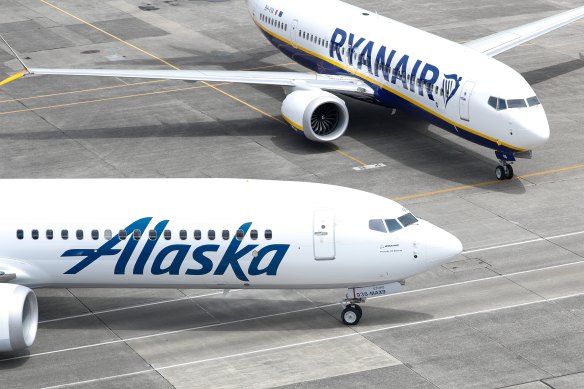Global manufacturing giant Boeing and its many airline clients became panicked over the weekend after a cabin panel on an Alaska Airlines aircraft flew open mid-flight.
The plane made an emergency landing and the 177 people on board landed safely, but it has caused air safety investigations all over the world to probe whether there may be issues with other Boeing 737 Max aircraft in operation.

A blown cabin panel aboard an Alaska Airlines flight over the weekend has sparked air safety investigations into Boeing’s 737 Max line used by major airlines all over the world. Credit: The Seattle Times
What happened on the Alaska Airlines flight?
Alaska Airlines flight 1282 was flying from Portland, Oregon, to Ontario, California, on the weekend when a plug holding one of its economy cabin doors blew off soon after take-off. This created a gaping hole in the body of the plane.
The flight made an emergency return to Portland where its 171 passengers and six crew landed safely. The hole occurred at almost 5000 metres and caused the aircraft to depressurise. Some passengers lost items of clothing and other personal items but no major injuries were reported.
The cabin door plug that flew open on the Max 9 can function as an emergency exit in certain configurations but is generally sealed. This is because few airlines that fly the Max 9 choose to fit it with its maximum 220 seats due to the extra weight and reduced cabin flexibility. In this instance, one of the plugs used to seal the extra door fell out.
The head of the US National Transportation Safety Bureau Jennifer Homendy told a press conference on Tuesday that pilots had previously reported pressurisation warning lights on three prior flights made by the affected aircraft earlier this month. It’s too early to tell whether these events were related to the Alaska Airlines incident.
Homendy said Alaska Airlines prevented the plane from making long-haul flights over water to ensure the aircraft was close to an airport in case an issue occurred but did not complete a requested maintenance check ahead of the incident.
Have any other issues been found?
Boeing has recommended all airlines that fly Boeing 737 Max 9s with the same cabin configuration as the affected aircraft to inspect their door panels for loose movement.
The US National Transport Safety Bureau initially said it did not expect its investigations to unearth a design flaw with the Max 9s. This door type has been in use on older Boeing 737s since 2006 and has not caused any serious issues.
But United Airlines – which operates 79 Max 9s – has since confirmed it has found loose bolts on the doors of some of its fleet. Alaska Airlines has also confirmed it’s located loose hardware on other aircraft in its fleet.
“Since we began preliminary inspections on Saturday, we have found instances that appear to relate to installation issues in the door plug – for example, bolts that needed additional tightening,” United said.
Boeing was forced to ground all Max 8s across the world after crashes in Indonesia in 2018 and Ethiopia in 2019 killed 346 passengers. The aircraft type was cleared to return to service in 2020 and is now used by more than 60 airlines all over the world, some of which fly to and from Australia.
Why did this incident ground other flights?
The only way the industry can assess whether the incident points to a broader manufacturing issue is by inspecting every aircraft in operation. There are 215 Max 9s in operation around the world and another 76 are on order, according to aviation data platform Cirium.
The bulk of the world’s Boeing 737 Max 9s are owned by US giants Alaska Airlines and United Airlines. The US Federal Aviation Administration ordered 171 Max 9s to be temporarily grounded for inspection on Monday.
“The FAA is requiring immediate inspections of certain Boeing 737 Max 9 planes before they can return to flight,” FAA Administrator Mike Whitaker said in a statement.
“Safety will continue to drive our decision-making as we assist the National Transportation Safety Bureau’s investigation into Alaska Airlines Flight 1282.”
There are no Max 9s configured with the affected door part in Europe, but some airlines in the region, including Turkish Airlines, have grounded their fleet for inspection anyway.
Max 9s are also flown by carriers in Asia and South America including Panama’s Copa Airlines, Mexico’s AeroMexico and Thailand’s Thai Lion Air.
Does the Max 9 fly in Australia?
No. There are no Boeing 737 Max 9s flown by Australian airlines or international airlines in Australia.
Two Australian airlines, and international carriers including Fiji Airways and Batik Air, do operate Boeing 737 Max 8s.
Boeing’s Max narrow body line has four variations – the Max 7, 8, 9 and 10 – and launched in 2016. The Maxs are more fuel-efficient than Boeing’s older 737s and have been quickly embraced by international giants including Ryanair which has 300 Max 10s on order.
Virgin Australia has three Boeing 737 Max 8s in operation across its domestic and international routes and another 11 due to arrive this year.
Virgin has also ordered 25 Boeing 737 Max 10s due to arrive from 2025, although this timeframe may be affected by the Alaska Airlines incident.
Fledgling budget carrier Bonza flies six Boeing 737 Max 8s, two of which have been leased from Canadian carrier Flair Airlines.
The Business Briefing newsletter delivers major stories, exclusive coverage and expert opinion. Sign up to get it every weekday morning.